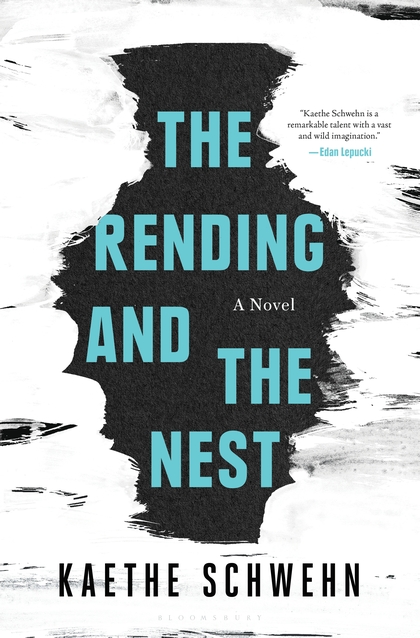The Rending and the Nest
- By Kaethe Schwehn
- Bloomsbury USA
- 304 pp.
- Reviewed by K.L. Romo
- March 3, 2019
This post-apocalyptic page-turner expertly weaves the threads of humankind’s new story.

One second, the world is as it should be; the next, 95 percent of it is gone. Few humans are left, even fewer animals. Most store merchandise has disappeared from shelves. Buildings are missing roofs or walls. Trees are leafless skeletons. The sky stays an eternal gunmetal grey, the sun an elusive memory:
“We called the event the Rending after the moment when Jesus died. The curtain torn. The moment of big death, life on the other side not yet known. And we called it the Rending for the way it made us feel afterward: torn, frayed, broken.”
If you are one who remains, the only thing you have from the Before is what you were touching at the moment of the Rending. Mira’s family was at the mall when the world changed, and she regrets the fact that she selfishly held jewelry instead of her little brother’s hand:
“I imagined myself in a…book called What Love Is Not: Advice from the Post-Apocalyptic Future that would begin: love is not abandoning your brother just before the end of the world for an H&M necklace.”
Mira must accept that she and others from the mall — plus stragglers they pick up while walking through a deserted landscape — are the only ones left. As they navigate the post-Rending world, they discover that the vanished objects sit in tall, toppling piles that decorate the earth like “a gigantic Jenga game.”
The group finally stops outside a vacant town and creates a new home, Zion, and the new rules they will live by. They purposely omit religion:
“We were still close enough to the Before to remember cults and to look around at our few numbers and our desperation for meaning and realize we could slide quickly into bizarre behavior meant as a hopeful attempt to keep the unthinkable at bay.”
Each member of Zion has a purpose: Mira scavenges the Piles for things the family needs (or she wants); Lana is the prostitute who barters her services; Rodney is the mechanic, the builder of things that make their lives bearable; Chester is the listener, the one who passes no judgment and gives hope to his flock with small, rolled-up fortunes (sans the cookie); Sylvia and Ida are the makeshift medics; Marjorie and Sven are the ghost-fruit cultivators; and Talia is a free spirit providing comfort and tea.
The one thing missing from their new world is children. There are none.
When Lana becomes pregnant three years after the Rending, those in Zion hope some sense of normalcy might return to their world. But that wish evaporates when she gives birth not to a baby, but to an inanimate object from her Before. As the other women of Zion become pregnant and give birth to their own “object” infants, they experience grief as if they’ve lost a living child.
Zionites soon discover the danger of their anguish and create rules for childbirth.
Visitors to Zion come and go, except for the charismatic Michael, who quickly inserts himself into their community. He collects stories of every person’s life — who they were in the Before and how the Rending permanently altered them. Michael mesmerizes audiences with his tales of loss and longing, and finally discloses that he not only gathers stories but collects humans, as well.
As Zion struggles with the grief of non-living children and the lure of Michael, pieces of the Before reveal themselves in each person’s story. The Rending gave everyone a do-over, a chance to rid themselves of their past. Although most long for their lives from the Before, some, like Chester, are guiltily happy to be reborn:
“Your eyes and the eyes of hundreds of people…did not register me. Not with pity or attraction or disdain. Nothing. I was like carpeting. And then the Rending. I opened my eyes and the world was the way I thought it should be. Everyone gone.”
Little by little, bits of the Before are revealed, surprising Mira as truths unfold. “And, stupidly, it didn’t occur to me that other members of Zion might have similarly curated their own pasts, track lighting and gleaming pedestals for the parts of themselves they wanted to remember and temperature-controlled basement storage for the parts of themselves they would just as soon forget.”
The concepts of forgiveness and rebirth are threaded throughout the novel with skill and grace. Searching the Piles is like looking for both the past and the future. Through it all, Zionites learn that “Love is a verb…so love makes us act: notes scribbled, roses purchases, hair brushed, ointment administered. Simple acts and tremendous ones.”
The Rending and the Nest left me with indelible images of the oddities contained within its pages, and I am moved by the prose which so eloquently describes a world that contains both bizarre atrocities and an innate hope for the future. This dystopian tale impresses upon us the importance of each of our stories, and that love and caring for one another is the only way to survive and start again.
[Editor's note: This review originally ran in 2018.]
K.L. Romo writes about life on the fringe: Teetering dangerously on the edge is more interesting than standing safely in the middle. She is passionate about women’s issues, loves noisy clocks and fuzzy blankets, but HATES the word normal. Her historical novel, Life Before, is about two women separated by a century who discover they’ve shared a soul. Find her on Twitter at @klromo.
_80_121.png)
